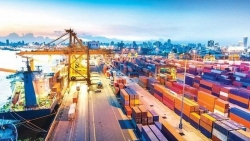Fire proves gold, adversity proves men
According to a report by the General Statistics Office (GSO) under the Ministry of Planning and Investment, in 2020, all socio-economic sectors in Viet Nam have been greatly impacted by the pandemic as the country is integrating intensively and extensively into the world.
Such activities as production, supply and commercial circulation, along with aviation, tourism and employment have been disrupted, the report said. Businesses have been hardest hit, with many suspended, bankrupted, dissolved and scaled down.
The report unveiled that in 10 months, up to 41,800 enterprises had to cease their operation, up 58.7 percent year-on-year, and 13,500 completed dissolution procedures, up 0.1 percent.
Given this, the Vietnamese business community has employed multiple solutions to maintain operation such as boosting e-commerce, offering new products and services, and seeking new markets.
During the 10-month period, about 3.8 quadrillion VND was injected into the economy, representing a rise of 17 percent over the corresponding time last year.
Total export-import value in the first 11 months was estimated at 489.1 billion USD, up 3.5 percent year-on-year, of which exports reached 254.6 billion USD, up 5.3 percent. Trade surplus in the reviewed period swelled to record high of 20.1 billion USD.
Viet Nam’s success in containing COVID-19 has also turned the country into a trust-worthy destination for foreign investors, as well as a promising and safe venue for the reallocation of international investments, with many major groups moving production out of China.
As of November 20, newly-registered and additional capital and share purchase by foreign investors totaled 26.43 billion USD.
Experts said businesses have reviewed their resilience, adaptability, weaknesses and strengths to revamp their production and business models towards efficiency and sustainability.
The pandemic has changed consumption demand, enabling Vietnamese enterprises to expand the market.
Notably, international integration policies will facilitate Vietnam’s deeper integration into the global value chain, and the formation of new value chains, experts said, suggesting the country bring into full play the EU-Vietnam Free Trade Agreement that took effect in August 2020.
The National Assembly has approved a resolution on socio-economic development plan for 2021, aiming to complete the dual goals of pandemic combat and socio-economic recovery and development.
Three fulcrums for economic recovery
Experts of the Asian Development Bank (ADB) believe that Viet Nam is showing stronger resilience than most similar economies and that its medium- to long-term economic outlook remains positive.
The Asian Development Outlook (ADO) 2020 Update, ADB’s annual flagship economic publication, says Viet Nam’s economy will benefit from the continued diversion of production from China to Viet Nam, and the implementation of the European Union – Viet Nam free trade agreement.
“Lower domestic consumption and weak global demand caused by COVID-19 have hurt Viet Nam’s economy more than expected. But economic growth will be resilient in 2020, in large part due to the government’s success in controlling the spread of COVID-19,” said ADB Country Director for Viet Nam Andrew Jeffries.
Economic growth will be supported by the country’s macroeconomic stability, increased public spending, and ongoing reforms to improve the business environment, he added.
ADO 2020 Update says Viet Nam’s economic outlook over the medium and long term remains positive. The country’s participation in a large number of bilateral and multilateral trade agreements will help the country’s economic rebound.
Viet Nam will also likely benefit from the current shifting of supply chains to low-cost countries, it says.
However, a prolonged global COVID-19 pandemic remains the biggest risk to Viet Nam’s growth outlook this year and next year, it notes, adding that another threat is global trade tensions, which lead to rising trade protection and financial risks that could be exacerbated by a prolonged pandemic.
Viet Nam’s economy is expected to grow 1.8 percent in 2020 amid the COVID-19 pandemic and bounce back to 6.3 percent in 2021, the experts believed.
Vo Tri Thanh, Director of the Institute of Branding and Competition Strategy, pointed out three fulcrums for Vietnam’s economic recovery, firstly production and export.
Public investment is likely to be stepped up thanks to the Government’s drastic measures, and a clearer legal framework, he added.
The third lies with private investment, particularly foreign direct investment, according to Thanh.

| Top 10 issues that defined the global economy in 2020 Here are the ten most significant global economic issues during the year. |

| Vietnam to become world’s 19th largest economy by 2035: CEBR Vietnam’s economy is expected to move to the 19th position in the rankings of the World Economic League Table in 2035, according to the Centre ... |

| Vietnam’s trade surplus hits record high despite COVID-19 Vietnam posted a record trade surplus of 20.1 billion USD in the first 11 months of this year despite the adverse impacts of the COVID-19 ... |


























